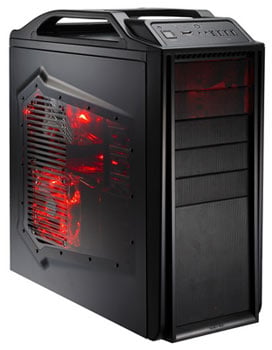Case In Point: Searching For the Perfect Mid-Tower
Sileo 500 and CM Storm Scout
Sileo 500
The Sileo 500 is a partially aluminum case, built on the same rough design as a number of the Cooler Master Centurion-style cases. In addition to being lighter, the case offers foam padding on the case side, bottom  and top panels to muffle the internal noise. The external panels are brushed aluminum, while the chassis skeleton is steel.
and top panels to muffle the internal noise. The external panels are brushed aluminum, while the chassis skeleton is steel.
Except for the use of brushed aluminum and the oddball power button, there’s little to distinguish this case visually from similar Cooler Master designs, like the Centurion 534. The power button is cleverly disguised as a transparent vertical strip at the bottom of the front bezel, which also serves as the power-on LED. It’s always entertaining to watch someone who’s never used the system hunt for the power button the first time.
The interior of the case is roomy enough to accept full size ATX motherboards and long graphics cards; the BFG 275 GTX OC currently lives inside the case, and it would likely accept the slightly longer Radeon HD 5870.
As for being a quiet case: this is really a standard case with additional eggcrate foam lining the interior. So it’s a little quieter, but if Cooler Master had stuck with steel case panels instead of aluminum, the case might have been even quieter. But this is no “silent” case by any means.
When the Sileo 500 first arrived, it was priced at nearly $100 US, which is too much. But you can now find it for as little as $50, which makes it a relative bargain.
CM Storm Scout
Cooler Master’s latest brand, CM Storm, is meant to appeal to hard core gamers. CM Storm offers two cases, the Scout and the Sniper. The CM Storm Scout is slightly smaller and lower priced than the Sniper; you can typically find it for around $90.
I actually like the look of the case, and the top mounted handles are actually sturdy, useful and don’t cut into your hands. On the other hand, I’m not a big fan of  transparent side panels, but the interior red light does set things off nicely. The good news is that the interior lighting can actually be disabled from a button on the top angled bezel.
transparent side panels, but the interior red light does set things off nicely. The good news is that the interior lighting can actually be disabled from a button on the top angled bezel.
All controls and ports are easily accessible from that top angled bezel. The reset button is small and slightly recessed, so it’s difficult to accidentally press – which is a good thing. The case is set up to route wiring behind the motherboard tray. The interior is painted flat black, which is both good and bad. It’s good, because the case looks good through that side panel. It’s bad, because you really need a good light to work inside the case; there’s no contrast inside the all-black interior.
The real downside of this case, though, is that it’s slightly too small. Full size ATX boards barely fit, and if the board has backwards facing SATA ports – something increasingly common – then attaching SATA connectors is a chore. And if you have a board slightly larger than a full-size ATX board, you’re out of luck, as I found out when I discovered that the Asus Rampage II Extreme can’t physically fit inside the case. Also, the main compartment is barely deep enough to accommodate a 10.5-inch graphics card – which means the ever-so-slightly larger Radeon HD 5870 won’t fit.
Still, it’s an easy case to move around, and it’s combination of low key color scheme and interesting lines make this an attractive case, if somewhat pricey. But this case would be so much better if it were two inches deeper and one inch wider.






